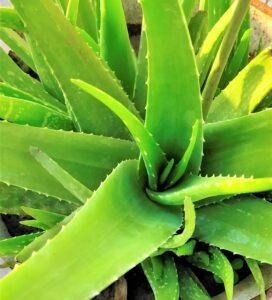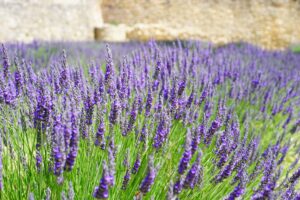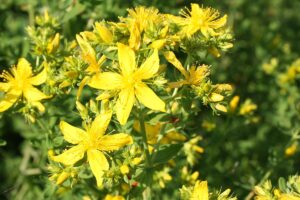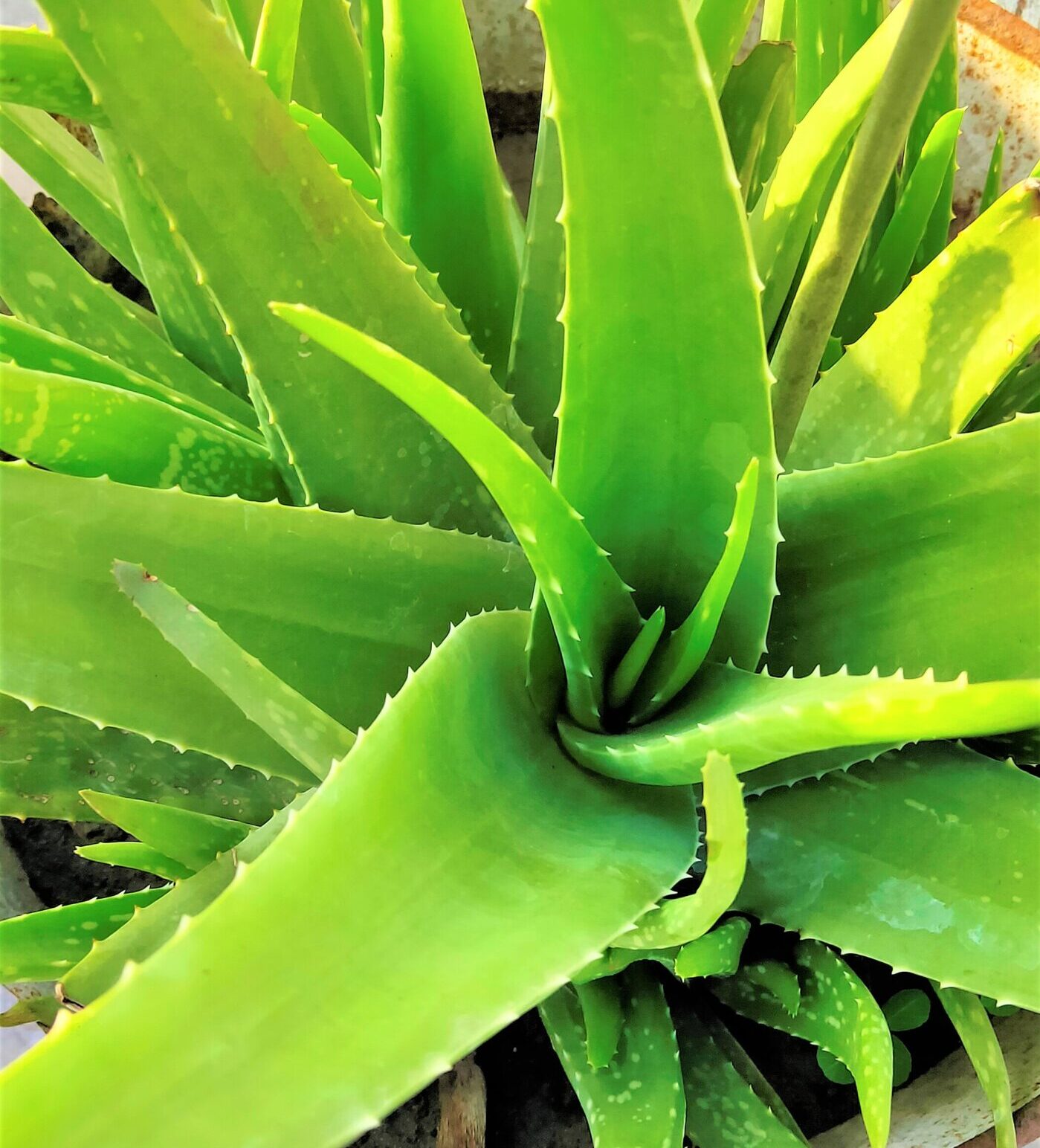The significance of medicinal plants extends beyond their historical use; modern scientific research continues to validate and uncover the therapeutic potential of many traditional remedies. With advancements in pharmacology and biochemistry, numerous plant-based compounds have been identified and studied for their health benefits, leading to the development of new medications and treatments. This article will highlight the top ten medicinal plants, selected based on their well-documented medicinal properties, widespread popularity, and substantial scientific research supporting their efficacy.
1. Aloe Vera (Aloe barbadensis)

(commons.wikipedia)
Description:
Aloe Vera is a succulent plant known for its thick, fleshy leaves that contain a gel-like substance. It belongs to the genus Aloe, which comprises over 500 species, but Aloe Vera is widely recognized for its medicinal properties.
Medicinal Uses:
Skin Healing: Aloe Vera gel is renowned for its ability to soothe and heal skin irritations, minor burns, sunburns, and wounds. It acts as a natural remedy for promoting skin regeneration and reducing inflammation.
Digestive Issues: When ingested, Aloe Vera juice or gel may help alleviate symptoms of digestive disorders such as constipation and irritable bowel syndrome (IBS). It is believed to have a gentle laxative effect due to its high fiber content and natural enzymes.
Benefits:
Anti-inflammatory Properties: Aloe Vera contains compounds like acemannan, which exhibit potent anti-inflammatory effects. This property makes it beneficial for treating inflammatory skin conditions such as eczema and psoriasis.
Antimicrobial Activity: The gel of Aloe Vera has natural antimicrobial properties that help inhibit the growth of bacteria and fungi. This makes it useful for preventing infections in wounds and promoting faster healing.
Moisturizing and Hydrating: Aloe Vera gel is rich in water content and vitamins (such as vitamin E and C), making it an excellent natural moisturizer. It hydrates the skin without leaving a greasy residue, making it suitable for all skin types, including oily and sensitive skin.
Application:
Aloe Vera gel can be applied topically directly from the plant’s leaves or in commercially available forms such as creams, lotions, and gels. For internal use, Aloe Vera juice is available and should be consumed in moderation due to its potential laxative effects.
Precautions:
While generally safe for topical use, some individuals may experience allergic reactions or skin irritation. When consuming Aloe Vera internally, it’s essential to follow recommended dosages and consult a healthcare professional, especially for pregnant women, breastfeeding mothers, and individuals with pre-existing medical conditions.
2. Ginseng (Panax ginseng)

(commons.wikipedia)
Description:
Ginseng is a perennial plant known for its fleshy roots and distinctive shape. It belongs to the genus Panax and is native to East Asia, particularly Korea, China, and Siberia. Ginseng is categorized into two main types: Asian or Korean ginseng (Panax ginseng) and American ginseng (Panax quinquefolius).
Medicinal Uses:
Boosts Energy: Ginseng is renowned for its ability to increase energy levels and combat fatigue. It is often used as a natural stimulant to improve stamina and physical endurance.
Reduces Stress: Ginseng is considered an adaptogen, helping the body cope with physical and mental stress. It may promote a sense of calmness and relaxation, supporting overall well-being.
Enhances Cognitive Function: Ginseng is believed to enhance cognitive abilities such as memory, concentration, and mental clarity. It is used to support brain function and improve cognitive performance.
Benefits:
Adaptogenic Properties: Ginseng contains bioactive compounds called ginsenosides, which exhibit adaptogenic properties. These compounds help the body adapt to stressors and maintain physiological balance.
Antioxidant Effects: Ginseng is rich in antioxidants, which help neutralize harmful free radicals and reduce oxidative stress. This property may contribute to its anti-aging effects and overall health benefits.
Potential Immune System Support: Some studies suggest that ginseng may enhance immune function by stimulating immune cells and improving resistance to infections.
Application:
Ginseng is commonly consumed in various forms, including dried roots, powders, extracts, and supplements. It can be brewed as tea or included in herbal formulations aimed at improving energy levels, reducing stress, and enhancing cognitive performance.
Precautions:
While generally safe for most people when used in recommended doses, ginseng may interact with certain medications and cause side effects such as headaches, digestive issues, and insomnia. It’s advisable to consult a healthcare professional before using ginseng, especially for individuals with pre-existing health conditions or those taking medications.
3. Echinacea (Echinacea purpurea)

(commons.wikipedia)
Description:
Echinacea is a flowering herbaceous plant native to North America, primarily found in the central and eastern regions. It belongs to the Asteraceae family and is characterized by its purple or pink daisy-like flowers and spiky central cones.
Medicinal Uses:
Immune System Support: Echinacea is widely used to support the immune system, helping to prevent and alleviate colds, flu, and other respiratory infections. It is believed to stimulate the body’s defense mechanisms and enhance immune response.
Colds and Respiratory Infections: Echinacea is particularly valued for its ability to reduce the severity and duration of cold symptoms such as sore throat, cough, and congestion. It may also help alleviate symptoms of upper respiratory tract infections.
Benefits:
Anti-inflammatory Properties: Echinacea contains active compounds like flavonoids and polysaccharides that exhibit anti-inflammatory effects. These properties contribute to its ability to reduce inflammation and promote healing.
Antiviral Activity: Echinacea has demonstrated antiviral properties, which may help inhibit the replication of viruses responsible for colds and flu.
Immune-Stimulating Effects: Echinacea stimulates the production and activity of immune cells such as macrophages and T-cells, thereby enhancing the body’s natural defenses against infections.
Application:
Echinacea is commonly consumed in various forms, including teas, extracts, tinctures, capsules, and throat lozenges. It is often used preventatively during cold and flu season or at the onset of symptoms to support immune function and aid recovery.
Precautions:
While generally considered safe for short-term use, prolonged use of Echinacea may reduce its effectiveness. Some individuals may experience mild side effects such as gastrointestinal upset or allergic reactions. It’s advisable to consult a healthcare professional before using Echinacea, especially for individuals with autoimmune disorders or allergies to plants in the Asteraceae family.
4. Turmeric (Curcuma longa)

(commons.wikipedia)
Description:
Turmeric is a herbaceous perennial plant native to South Asia, belonging to the ginger family (Zingiberaceae). It is characterized by its bright yellow-orange rhizomes (underground stems) and lance-shaped leaves.
Medicinal Uses:
Anti-inflammatory: Turmeric is renowned for its powerful anti-inflammatory properties, primarily attributed to its active compound, curcumin. It helps reduce inflammation in the body, which may alleviate symptoms of arthritis, joint pain, and inflammatory conditions.
Antioxidant: Turmeric is a potent antioxidant, protecting cells from damage caused by free radicals. This property contributes to its anti-aging effects and potential benefits for overall health.
Digestive Aid: Turmeric stimulates bile production in the liver, aiding digestion and promoting the breakdown of fats. It is used to support digestive health and alleviate symptoms of indigestion and bloating.
Benefits:
Curcumin Compound: Curcumin is the main bioactive compound in turmeric responsible for its medicinal properties. It has been extensively studied for its potential benefits, including:
- Joint Health: Curcumin may help reduce joint pain and stiffness associated with arthritis and improve overall joint function.
- Heart Health: Turmeric may support cardiovascular health by improving endothelial function, reducing inflammation in blood vessels, and potentially lowering cholesterol levels.
- Potential Cancer Prevention: Curcumin exhibits anti-cancer properties by inhibiting the growth of cancer cells, reducing tumor formation, and enhancing the body’s natural antioxidant defenses.
Application:
Turmeric can be consumed fresh, dried, or in powdered form. It is commonly used in cooking, especially in curries and spice blends. Turmeric supplements and extracts standardized for curcumin content are also available for therapeutic purposes.
Precautions:
Turmeric is generally safe when consumed in culinary amounts or as a supplement within recommended dosages. However, high doses or prolonged use may cause gastrointestinal discomfort or interact with certain medications. Individuals with gallbladder disease, bleeding disorders, or those taking blood-thinning medications should exercise caution and consult a healthcare professional before using turmeric supplements.
5. Peppermint (Mentha × piperita)

(commons.wikipedia)
Description:
Peppermint is an aromatic perennial herb belonging to the mint family (Lamiaceae). It is a hybrid of watermint and spearmint, characterized by its square stems, dark green leaves with a purplish hue, and small lilac or pink flowers. Peppermint is cultivated worldwide for its essential oil and culinary uses.
Medicinal Uses:
Digestive Disorders: Peppermint is widely used to relieve digestive issues such as indigestion, bloating, gas, and irritable bowel syndrome (IBS). Its soothing effects on the gastrointestinal tract help ease discomfort and improve digestion.
Headaches: Peppermint oil, when applied topically, can help alleviate tension headaches and migraines. The cooling sensation of menthol provides a soothing effect that may reduce headache severity.
Cold Symptoms: Peppermint is commonly used to relieve symptoms of the common cold, such as congestion, sore throat, and cough. Its menthol content acts as a decongestant, helping to clear nasal passages and ease breathing.
Benefits:
Calming Effects on the Stomach: Peppermint has a relaxing effect on the muscles of the gastrointestinal tract, which can help reduce spasms and cramping. This makes it particularly effective for treating conditions like IBS.
Antispasmodic Properties: The antispasmodic action of peppermint helps to relax smooth muscles, alleviating symptoms of digestive disorders and providing relief from menstrual cramps.
Antimicrobial Actions: Peppermint possesses natural antimicrobial properties, which can help inhibit the growth of bacteria, fungi, and viruses. This makes it useful for treating minor infections and preventing their spread.
Application:
Peppermint can be consumed in various forms, including:
Tea: Peppermint tea is a popular remedy for digestive issues and cold symptoms. It can be made by steeping fresh or dried peppermint leaves in hot water.
Oil: Peppermint essential oil is used in aromatherapy, topical applications, and as a flavoring agent. It can be diluted with a carrier oil and applied to the skin or inhaled for its therapeutic benefits.
Capsules: Enteric-coated peppermint oil capsules are available as supplements for treating IBS and other digestive disorders.
Precautions:
Peppermint is generally safe when used in moderate amounts. However, high doses of peppermint oil can cause adverse effects such as heartburn, allergic reactions, and skin irritation. It is advisable to consult a healthcare professional before using peppermint oil, especially for individuals with gastroesophageal reflux disease (GERD), gallstones, or during pregnancy and breastfeeding.
6. Chamomile (Matricaria chamomilla)

(commons.wikipedia)
Description:
Chamomile is a herbaceous plant known for its small, daisy-like flowers with white petals and yellow centers. It belongs to the Asteraceae family and is native to Europe and Western Asia. Chamomile has a pleasant, apple-like fragrance and is widely used in herbal remedies and teas.
Medicinal Uses:
Sleep Aid: Chamomile is renowned for its ability to promote sleep and improve sleep quality. It is commonly used as a natural remedy for insomnia and other sleep disorders due to its mild sedative effects.
Relaxation: Chamomile is often consumed to reduce stress and anxiety. Its calming properties help induce relaxation and can ease feelings of tension and restlessness.
Digestive Complaints: Chamomile is effective in soothing digestive issues such as indigestion, bloating, gas, and stomach cramps. It aids digestion and helps relieve discomfort associated with gastrointestinal disorders.
Benefits:
Anti-Anxiety Effects: Chamomile contains compounds like apigenin that bind to certain receptors in the brain, promoting relaxation and reducing anxiety. This makes it a popular choice for individuals seeking natural ways to manage stress and anxiety.
Anti-Inflammatory Properties: Chamomile possesses anti-inflammatory properties that help reduce inflammation and pain. It is used to treat inflammatory conditions such as arthritis, muscle pain, and skin irritations.
Gentle Sedative Qualities: Chamomile acts as a gentle sedative, making it ideal for those who need a mild calming effect without the risk of dependency or significant side effects. It can help improve sleep patterns and overall well-being.
Application:
Chamomile is commonly consumed in various forms, including:
- Tea: Chamomile tea is one of the most popular ways to consume chamomile. It can be made by steeping dried chamomile flowers in hot water. Drinking chamomile tea before bedtime can promote relaxation and improve sleep quality.
- Extracts and Tinctures: Chamomile extracts and tinctures are available for more concentrated doses. They can be added to water or other beverages for their calming and digestive benefits.
- Topical Applications: Chamomile is used in creams, ointments, and bath products for its soothing effects on the skin. It can help alleviate skin irritations, rashes, and minor wounds.
Precautions:
Chamomile is generally safe for most people when used in moderate amounts. However, some individuals may experience allergic reactions, especially those who are allergic to plants in the Asteraceae family. It is advisable to consult a healthcare professional before using chamomile, especially for pregnant or breastfeeding women and individuals taking medications that interact with chamomile.
7. Garlic (Allium sativum)

(commons.wikipedia)
Description:
Garlic is a bulbous plant belonging to the Amaryllidaceae family. It is characterized by its strong-smelling, segmented bulbs, known as cloves. Garlic is native to Central Asia and has been cultivated for thousands of years for both culinary and medicinal purposes.
Medicinal Uses:
Cardiovascular Health: Garlic is widely recognized for its beneficial effects on heart health. It helps lower cholesterol levels, reduce blood pressure, and improve overall cardiovascular function. Regular consumption of garlic can contribute to a healthier heart and reduced risk of heart disease.
Immune System Support: Garlic is known for its immune-boosting properties. It helps enhance the body’s natural defense mechanisms, making it effective in preventing and fighting off common illnesses like colds and flu.
Antimicrobial Effects: Garlic possesses natural antimicrobial properties, making it effective against a wide range of bacteria, viruses, and fungi. It is used to treat infections and support overall immune health.
Benefits:
Allicin Compound: Allicin is the primary active compound in garlic responsible for its medicinal properties. It is formed when garlic is crushed or chopped and has powerful antioxidant and anti-inflammatory effects.
- Lowering Cholesterol: Allicin helps reduce total cholesterol and low-density lipoprotein (LDL) levels, often referred to as “bad” cholesterol, thereby improving cardiovascular health.
- Blood Pressure Regulation: Garlic has been shown to help lower blood pressure by promoting the dilation of blood vessels and improving blood flow. This can reduce the risk of hypertension and associated complications.
- Potential Anti-Cancer Properties: Some studies suggest that garlic may have anti-cancer effects, particularly in reducing the risk of certain cancers like stomach and colorectal cancer. Allicin and other sulfur compounds in garlic are believed to inhibit the growth of cancer cells and induce apoptosis (programmed cell death).
Application:
Garlic can be consumed fresh, cooked, or in supplement form. Common methods of consumption include:
- Raw: Eating raw garlic cloves can provide the most potent health benefits, but it may be too strong for some individuals.
- Cooked: Incorporating garlic into meals by cooking it enhances flavor and still provides health benefits, though some of the active compounds may be reduced by heat.
- Supplements: Garlic supplements, including garlic oil and powdered garlic, are available for those who prefer not to consume raw or cooked garlic. These supplements often standardize allicin content for consistent dosing.
Precautions:
While garlic is generally safe for most people, it can cause digestive discomfort in some individuals, especially when consumed in large amounts. It may also interact with certain medications, such as blood thinners, and should be used with caution by individuals with bleeding disorders. It is advisable to consult a healthcare professional before using garlic supplements, especially for those with underlying health conditions or those taking medications.
8. Lavender (Lavandula angustifolia)

(pxhere.com)
Description:
Lavender is a fragrant perennial shrub belonging to the mint family (Lamiaceae). It is characterized by its slender stems, gray-green leaves, and clusters of small, aromatic purple flowers. Native to the Mediterranean region, lavender is cultivated worldwide for its essential oil and ornamental beauty.
Medicinal Uses:
Relaxation: Lavender is widely known for its calming and soothing properties. It is used to promote relaxation and reduce stress and anxiety. Lavender essential oil is often used in aromatherapy to create a sense of calmness and tranquility.
Anxiety Relief: Lavender has been shown to help alleviate symptoms of anxiety and nervousness. Inhaling lavender oil or using it in massage can have a relaxing effect on the nervous system.
Sleep Disorders: Lavender is commonly used as a natural remedy for insomnia and other sleep disorders. Its sedative properties help improve sleep quality and promote a restful night’s sleep.
Benefits:
Calming Effects: The aromatic compounds in lavender, such as linalool and linalyl acetate, have been shown to reduce stress and anxiety levels. These compounds interact with the brain’s neurotransmitters to promote relaxation and enhance mood.
Anti-Inflammatory Properties: Lavender possesses anti-inflammatory properties that can help reduce inflammation and pain. It is used to treat minor burns, insect bites, and inflammatory skin conditions.
Skin Healing Benefits: Lavender oil has antimicrobial and antiseptic properties that make it effective in treating skin conditions such as acne, eczema, and psoriasis. It promotes healing and reduces scarring.
Application:
Lavender can be used in various forms, including:
- Essential Oil: Lavender essential oil is one of the most popular forms and can be used in aromatherapy, massage, and topical applications. It can be diffused in the air, added to bath water, or diluted with a carrier oil and applied to the skin.
- Tea: Lavender tea, made from dried lavender flowers, is a soothing beverage that promotes relaxation and aids digestion.
- Topical Creams and Ointments: Lavender-infused creams and ointments are available for treating skin conditions and promoting healing.
Precautions:
Lavender is generally safe for most people when used in moderate amounts. However, it can cause allergic reactions or skin irritation in some individuals. It is important to dilute lavender oil before applying it to the skin and to perform a patch test to check for any adverse reactions. Pregnant and breastfeeding women, as well as individuals with hormone-sensitive conditions, should consult a healthcare professional before using lavender products.
9. Ginkgo (Ginkgo biloba)

(commons.wikipedia)
Description:
Ginkgo, also known as the maidenhair tree, is a deciduous tree native to China. It is notable for its unique fan-shaped leaves and its long history, dating back over 200 million years. Ginkgo is one of the oldest living tree species, and its seeds and leaves have been used in traditional medicine for centuries.
Medicinal Uses:
Cognitive Function: Ginkgo is widely used to enhance cognitive function and improve memory. It is often taken as a supplement to support brain health and mental clarity.
Memory Enhancement: Ginkgo is known for its potential to improve memory and cognitive performance, particularly in older adults. It is commonly used to help manage symptoms of dementia and Alzheimer’s disease.
Circulation Improvement: Ginkgo is beneficial for improving blood circulation. It helps increase blood flow to the brain and extremities, which can be helpful for conditions such as peripheral artery disease and Raynaud’s disease.
Benefits:
Flavonoids and Terpenoids: Ginkgo contains potent antioxidants, including flavonoids and terpenoids, which protect cells from oxidative damage and reduce inflammation. These compounds contribute to Ginkgo’s neuroprotective effects and overall health benefits.
Brain Health: The antioxidants in Ginkgo help protect brain cells from damage and support healthy brain function. Regular use of Ginkgo supplements is believed to enhance cognitive performance, improve focus, and reduce mental fatigue.
Potential Anti-Aging Effects: Ginkgo’s antioxidant properties may help slow down the aging process by protecting cells from oxidative stress. This can contribute to improved overall health and longevity.
Application:
Ginkgo can be consumed in various forms, including:
- Supplements: Ginkgo biloba supplements are available in capsules, tablets, and liquid extracts. These supplements are standardized to contain specific amounts of active compounds for consistent dosing.
- Tea: Ginkgo leaf tea is another popular way to consume this medicinal plant. The tea can be made by steeping dried ginkgo leaves in hot water.
- Extracts: Ginkgo extracts are used in various herbal formulations and can be added to beverages or taken directly.
Precautions:
While Ginkgo is generally considered safe for most people, it can cause side effects such as gastrointestinal upset, headache, and dizziness in some individuals. Ginkgo may also interact with certain medications, including blood thinners and anticoagulants, potentially increasing the risk of bleeding. It is important to consult a healthcare professional before using Ginkgo supplements, especially for individuals with bleeding disorders or those taking medications that affect blood clotting.
10. St. John’s Wort (Hypericum perforatum)

(commons.wikipedia)
Description:
St. John’s Wort is a flowering perennial herb belonging to the Hypericaceae family. It is characterized by its bright yellow flowers with black dots on the petals and perforated-looking leaves when held up to the light. Native to Europe, it has been used for centuries for its medicinal properties.
Medicinal Uses:
Depression: St. John’s Wort is widely used as a natural remedy for mild to moderate depression. It is believed to help balance mood and improve symptoms of depression.
Anxiety: The herb is also used to alleviate symptoms of anxiety and promote a sense of calm. It can help reduce feelings of nervousness and tension.
Nerve Pain: St. John’s Wort is used to treat nerve pain and conditions such as sciatica and neuralgia. Its analgesic properties can help relieve pain and discomfort.
Benefits:
Hypericin and Hyperforin Compounds: St. John’s Wort contains active compounds such as hypericin and hyperforin, which are believed to contribute to its antidepressant effects. These compounds influence neurotransmitter activity in the brain, helping to stabilize mood and improve mental health.
- Mood Stabilization: Hypericin and hyperforin help regulate the levels of serotonin, dopamine, and norepinephrine in the brain, which can enhance mood and alleviate depressive symptoms.
- Antidepressant Effects: St. John’s Wort is considered a natural antidepressant and is often used as an alternative to prescription antidepressants for treating mild to moderate depression.
- Potential Anti-Inflammatory Actions: The herb has anti-inflammatory properties that may help reduce inflammation and pain, particularly in conditions involving nerve pain and inflammation.
Application:
St. John’s Wort can be consumed in various forms, including:
- Extracts and Tinctures: St. John’s Wort extracts and tinctures are concentrated forms that can be taken orally or added to beverages.
- Capsules and Tablets: Standardized St. John’s Wort supplements are available in capsule and tablet form for consistent dosing.
- Tea: St. John’s Wort tea is made by steeping dried flowers in hot water. Drinking the tea can provide a mild calming effect and support mental well-being.
Precautions:
St. John’s Wort can interact with various medications, including antidepressants, birth control pills, anticoagulants, and certain cancer treatments. These interactions can reduce the effectiveness of the medications or increase the risk of side effects. It is important to consult a healthcare professional before using St. John’s Wort, especially for individuals taking other medications or those with underlying health conditions. Additionally, St. John’s Wort can cause photosensitivity, making the skin more susceptible to sunburn. Avoid excessive sun exposure and use sun protection when using the herb.
Conclusion,
Summarize the importance of medicinal plants in traditional and modern medicine, emphasizing their diverse uses and ongoing scientific research validating their benefits. Encourage readers to explore these plants under guidance from healthcare professionals for safe and effective use.



